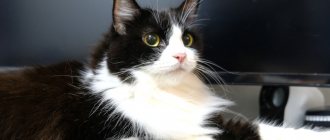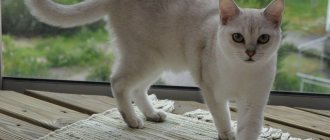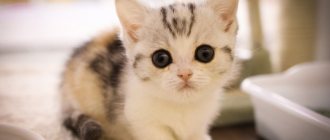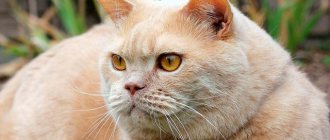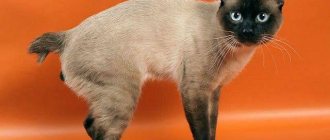Origin story
Officially, the year of birth of the Laperm breed is considered to be 1982: when a hairless kitten was born on an ordinary farm in the American town of Dallas. His mother was a simple mongrel cat, his father was a “visiting” cat-traveler, so the birth of a baby without hair, but with bluish spots on the skin, was treated rather indifferently: what to take from the little freak? Let him live.
However, after a couple of months, the owners were pleasantly surprised: the kitten’s body was covered with unusually soft to the touch, and most importantly, curly fur of a beautiful shade. Naturally, they named the baby Curly.
Over time, the number of curly-haired cats increased and the owners began to wonder: what’s the matter? A couple of cats were taken to a local exhibition and shown to specialists, and they rendered a verdict: they had never seen such an amazing mutation, which means that a new, unprecedented breed had appeared. And it should be developed further.
Richard and Linda Coel, the owners, did not put the matter on hold. It turned out that the curly gene is the dominant gene, and it is transmitted both through the mother and through the father. This greatly simplified the breeding task. The first nursery was opened, several exhibitions were held, and work began to stabilize the breed. The crossbreeding involved Manx cats, Siamese cats, and domestic mongrel cats of similar build.
In 1997, a standard was drawn up, and the breed was gradually recognized one by one by major world felinological organizations: TICA in 2002, CFA in 2008, ACFA in 2011, ACFA in 2011. In 2022, the breed became closed, i.e. cats are no longer allowed to be crossed with other breeds.
The name of the breed consists of the English “perm” - perm and the French article “la”.
Description of the breed
LaPerm cat breed
It is almost impossible to confuse LaPerms with other breeds. It's all about the thick, curly coat. There are long-haired and short-haired representatives. Because of this, this option is not suitable for people with allergies.
LaPerm cats are not large, weighing about 3 kg. They have refined features in appearance, expressive eyes and lively facial expressions. Looking at your pet, you can immediately determine what emotional state he is in. They have a specific body structure - the lower back is higher than the shoulders due to the excessive development of the limbs. Therefore, visually it seems that the cat is moving “on tiptoes.” The measured movements are emphasized by an elegant tail.
Puberty in Laperms occurs at 2.5-3 years. Cats mature earlier than males. Kittens are born with even fur or no fur at all. Only closer to six months do curls appear.
Standards
Laperm are quite large cats. Females are usually smaller than males and weigh 2-2.5 kg. Males can exceed the 5 kg bar. They are proportionally built, muscular, but at the same time elegant and graceful.
| Standard | Description |
| Head | The skull is wedge-shaped, rounded. The whisker pads are dense, round, and the whiskers are long. The chin is strong, the forehead is flat. |
| Ears | Cup-shaped, spaced far apart, abundantly pubescent. If the coat is long, lush tassels at the ends are allowed. |
| Eyes | Not very big, but expressive. When a cat is calm, its eyes are almond-shaped and expressive; when frightened, they become round, like coins. The color of the iris can be any and is not tied to the shade of the coat. |
| Torso | Medium in size, finely boned. The back is slightly higher than the shoulder girdle. |
| Limbs | Long, slender, the front ones are slightly shorter than the rear ones. The paws are rounded and flattened. |
| Tail | Equal to the length of the body, tapering towards the tip. |
Special mention should be made about wool. Laperms are divided into short-haired and long-haired.
The coat of short-haired cats is airy, light and wavy, but in some individuals it can be harsh. It lies in large waves, there is often a “collar” in the neck area, and tassels on the ears, but their absence is not considered a defect. The tail looks like a bottle brush.
Long-haired individuals have disheveled fur, a soft “collar” is always present on the neck, and the tail resembles a plume. It can be either curly or wavy, it can change density depending on the season, but it should always be airy and light. This is easy to check: if you blow on it, it moves apart. Hangs along the spine.
Laperm kittens are born hairless, and curls begin to appear at about 2 months of age.
Significant deficiencies for which points will be deducted in competitions:
- Tiger pattern on the coat, spots;
- Different wool texture.
An animal is removed from the competition if it has:
- Strabismus;
- Paws that are too short or massive;
- The body is stocky and large;
- There are extra fingers;
- The coat is not curly or wavy, but straight and thick;
- Cryptorchidism;
- The tail is short or too long, with bumps or knots visible on it;
- Bald spots and bald patches are clearly visible on the fur of adult cats (over a year old).
Do you want to buy a curly-haired kitten? Contact the nursery. When buying a baby secondhand, you risk running into scammers. The cost of one kitten is at least 400 dollars. A healthy kitten, raised in love, has clean and clear eyes, ears and mouth, it does not run wild and does not shy away from human hands. Pedigree is required if you are planning breeding: the data is printed on the organizational form and secured by the signature of the manager. A veterinary passport is also required, which must contain information about vaccinations.
How much does a kitten cost?
This is a young and rather rare breed, but has already gained recognition. There are no nurseries in Russia that breed it. If you intend to purchase a LaPerma kitten, all you have to do is look for private breeders.
The price for a small LaPerma starts at $500 and can go up to $5,000. It depends on the quality of the “product”.
If a kitten has straight, rather than curly, fur, this is not a defect, but a natural design. They give birth to curly-haired offspring with the preservation of all other breed characteristics. Such cats cannot participate only in exhibition shows.
Colors
Experts allow any colors: both pure and in combination. The most common are the following:
- Black (nose and paw pads are also jet black);
- White (pink paws and nose);
- Red (pink nose and paws, ticking not desirable);
- Ivory (paw pads and nose are colored cream);
- Brown (both light and dark chocolate shade).
In the photo there are cats of the LaPerm breed of popular colors: red, black, white.
The total number of colors in the standard is 30. Hereditary: tabby and tortoiseshell.
Interesting Facts
The LaPerm breed has not existed for long, but a lot of interesting things can already be told about it.
- Most cats are not afraid of water at all. They happily frolic in the rain and swim in the bathtub.
- One of the "talkative" breeds. Pets constantly rumble and purr, and their voice does not hurt human ears. On the contrary, it calms.
- These representatives shed intensely, sometimes to the point of complete baldness. Then they are re-grown with curly hair.
- Laperms are distinguished by their remarkable intelligence. They instantly remember their nickname and respond to it. They are easy to teach different tricks.
Starting from 2022, it is planned to prohibit crossing LaPerms with representatives of other breeds. In this way, they strive to fix the phenotype at the genetic level.
Character and behavior
This wonderful curly ball is incredibly kind and affectionate. He experiences the kindest emotions towards a person, does not hesitate to demonstrate his affection: he strives to climb onto his owner’s shoulder and lick his nose and ears, touch his face with his paws, look into his eyes. The cat’s favorite place is the shoulders and chest of a person, and in the hands the cat feels absolutely protected.
Name the cat who always wanted to live together
BasilioLeopold
She is inquisitive, but at any moment she is able to drop what she’s doing and rush to the call. Playful, but only if someone keeps her company. If a person refuses to chase a ball and prefers to sit with a book or in front of the TV, he will purr and sit next to him, and will be quite happy with this pastime. It may seem intrusive because it follows its leader literally on his heels, trying not to lose sight of him for a second.
Applies equally well to both adults and children. He plays with the kids with great joy, patiently endures being poked and pulled by the tail, and when it becomes completely unbearable, he tries to slowly sneak away to his house. Other animals living in the same territory as the laperm arouse great interest in her and a desire to make friends. And it doesn’t matter whether they are cats or dogs. But other, smaller creatures awaken hunting instincts, because cats of this breed are surprisingly dexterous hunters! With all this (surprisingly) they are absolutely not jealous.
Expert opinion
Dusheba Vera Ivanovna
In 2010, she graduated from the Moscow State Academy of Veterinary Medicine named after K.I. Scriabin with honors, specializing in veterinary medicine. I regularly attend veterinary conferences, congresses, and webinars.
Kittens can be taken from their mother at the age of 5-6 months. There are several reasons for this. Firstly, in the first 2 months, kittens develop immunity (and the mother helps with this). Secondly, funny curls appear by 4 months. Thirdly, these kittens are very attached to their mother and early separation causes serious harm to their psyche. Wait a little: the mother cat will be better able to teach the kitten the necessary skills than you - to use the litter box and eat, communicate with her own kind and people.
They get along well both in city apartments and in private houses, but in both places they require regular walks. Train your pet to use a leash from an early age.
He is not afraid of strangers and happily runs to meet them. Willingly allows himself to be stroked and even picked up.
A significant drawback is the following: Laperm does not take punishment seriously. If he breaks a vase and the owner scolds him, the cat will decide that the reason is a bad mood, and not the vase. You will have to be very patient and control yourself because this can be difficult to deal with at times.
An overly friendly character can lead to problems on walks. Seeing a dog, a laperm can rush to it to “say hello”, and this poses a serious danger to its health and even life. Don't let your pet run around without a leash and in general: don't take your eyes off him.
Care instructions
It is believed that this breed is less allergenic than others. Reason: lack of undercoat. However, this can only be verified experimentally.
Wool
Caring for a Laperm cat is not difficult, but it requires care. Her curly fur does not tolerate hot air, so you cannot use a hairdryer after bathing, and don’t let her lie near radiators breathing heat - the “curl” will be ruined.
Expert opinion
Dusheba Vera Ivanovna
In 2010, she graduated from the Moscow State Academy of Veterinary Medicine named after K.I. Scriabin with honors, specializing in veterinary medicine. I regularly attend veterinary conferences, congresses, and webinars.
Cats should not be bathed often: firstly, they themselves are good at “making a mess”, and secondly, water and detergents (even the best) wash away the protective layer from the skin, which can cause various types of irritation. Take your pet to the bathroom if he is so dirty (for example, in soot, oil, or something disgusting-smelling) that he definitely cannot clean himself properly. And also: before the exhibition and childbirth. The first bath is not earlier than 4-5 months (when baby teeth fall out).
It is enough to comb once a week, during shedding - 2-3 times. You need a comb with rubber teeth, a brush with natural bristles. You can also collect excess hair from the body with your hands: wet them and pull the skin a little.
Ears
Ears are examined and cleaned once a week. Excess wax is wiped off with a cotton swab dipped in boiled water or ear lotion. Under no circumstances should you pour liquid into your ear!
Teeth
Teeth are brushed once a month. To do this, buy cat paste with the taste of meat or valerian and a soft brush with short bristles at the veterinary store. If the cat is patient and does not show aggression, you can wrap a piece of gauze around your finger and brush its teeth with it.
Claws
Keeping nails trimmed or trimming depends on how often your cat uses the scratching post. If you don't notice much enthusiasm and she is clearly lazy, you will have to help her.
The claws are cut like this: the cat is fixed in one position (you can wrap it in a towel or ask someone in your household for help) and the tips of the claws are bitten off with a nail clipper. All this is done extremely carefully so as not to touch large vessels and not injure the paw.
Catering
Lapermas are not capricious when it comes to food, but you need to immediately decide how you will feed your pet: should you cook the food yourself or buy ready-made dry and wet food? Both the first and second options have many advantages, but they also have their disadvantages.
Natural products
Natural nutrition, balanced and properly selected, allows you to fully satisfy all the body's needs for nutrients, minerals and vitamins. When choosing products, you can check their quality yourself, choose a more suitable price, and, ultimately, diversify your diet with one dish or another. And the cat definitely won’t get tired of it.
The grocery basket cannot include the following products:
- Fatty meat, lard, tripe (hard on the stomach, high risk of infection with parasites);
- River fish (the same parasites and the risk of developing urolithiasis);
- Marinades, sugar, salt, seasonings, spices (disrupt metabolism);
- Chocolate, mushrooms, eggplants (poisonous);
- Legumes, potatoes (provoke increased gas formation);
- Drinks with caffeine (put stress on the heart);
- Onions, garlic, tomatoes, avocados (cause gastrointestinal upset);
- Nuts, dried fruits (load on the kidneys).
It is also better to exclude salty, smoked, sour foods, citrus fruits, raisins, whole cow's milk, baked goods and flour - they are not beneficial. The same applies to juices, compotes, dog food, canned human food and vitamins.
Here's what you can and should give:
- Porridges cooked in water: rice, oatmeal, millet, buckwheat, pearl barley, semolina;
- Stewed vegetables: zucchini, pumpkin, carrots, beets, broccoli, Brussels sprouts, green salad, parsley, dill;
- Boiled chicken yolk, quail and turkey eggs;
- Raw or cooked lean meat: beef, veal, chicken, lamb and rabbit;
- Sea fish: flounder, trout, hake, salmon (once a week you can treat your cat with boiled peeled shrimp and squid);
- Fermented milk products: organic yogurt, cottage cheese, unsalted hard cheese, yogurt, sour cream, cream;
- Apples, cucumbers, melon, corn.
Give your pet only clean water: settled or passed through a special filter. You can also buy bottled water at the store. Change it 2 times a day and wash the bowl more often.
Recommended food
Ready-made food is convenient if you don’t have time to cook. Choose food from the holistic group: they have the best composition and a good vitamin and mineral supplement. These are Acana, Farmina N&D, Savarra. However, super-premium food is also suitable. But accustom the animal to the food gradually and monitor its reaction: if the cat develops diarrhea, constipation, or skin rashes, replace it with another one.
Below are recommended super-premium foods. Links with the names of the food are clickable, on them you can, within our website, read the descriptions of the food and read reviews from owners of LaPerm cats.
| Holistic | Holistic | Super premium |
| Grandorf | Power of Nature | Organix |
Feeding the cat
Laperma can be given both industrial and natural food. In the first case, the curly-haired cat is fed premium or super-premium class dry food, which contains all the necessary microelements and does not contain any questionable additives.
These requirements are best met by:
- Royal Canin;
- Monge;
- Bosch;
- Brit Care.
When feeding natural products, the Laperm diet is thought out so that it is based on lean, fresh meat. Also included in the menu for curly cats:
- boiled vegetables;
- porridge with water;
- eggs;
- dairy products;
- lean sea fish;
- offal.
Cats of this breed should not be fed bones, sweets, baked goods, sausages or whole milk. Laperms are also forbidden to give river fish, smoked meats, pickles and any food from the master’s table.
Diseases
This breed has no genetic pathologies, however, hereditary diseases are also not noted. But representatives of this breed are not immune from ordinary cat diseases. Therefore, be sure to give your animal all important vaccinations and anti-worm medications.
Rabies, calcivirosis, rhinotracheitis, panleukopenia, chlamydia, peritonitis (infectious), microsporia and trichophytosis are the main and most common diseases that cause animals a lot of suffering and often lead to death. Vaccinations against them are done once a year, and deworming is carried out beforehand. High-quality vaccines: “Nobivak”, “Quadricat”, “Leukorifelin”, “Fel-o-vax”, “Multifel”.
Laperms have one peculiarity: fleas, once on their skin, often provoke the development of allergies. Therefore, regularly examine your pet and if you notice insects, immediately begin treating it with special preparations. Otherwise, the situation will only get worse.
Characteristics of Laperm
| Attachment level | Medium to high |
| Friendliness | Medium to high |
| Suitable for children | Medium to high |
| Loyalty to other pets | Medium to high |
| Exercise needs | High |
| Playfulness | High |
| Energy level | High |
| Intelligence | High |
| Tendency to meow | Low |
| Shedding intensity | Low |
